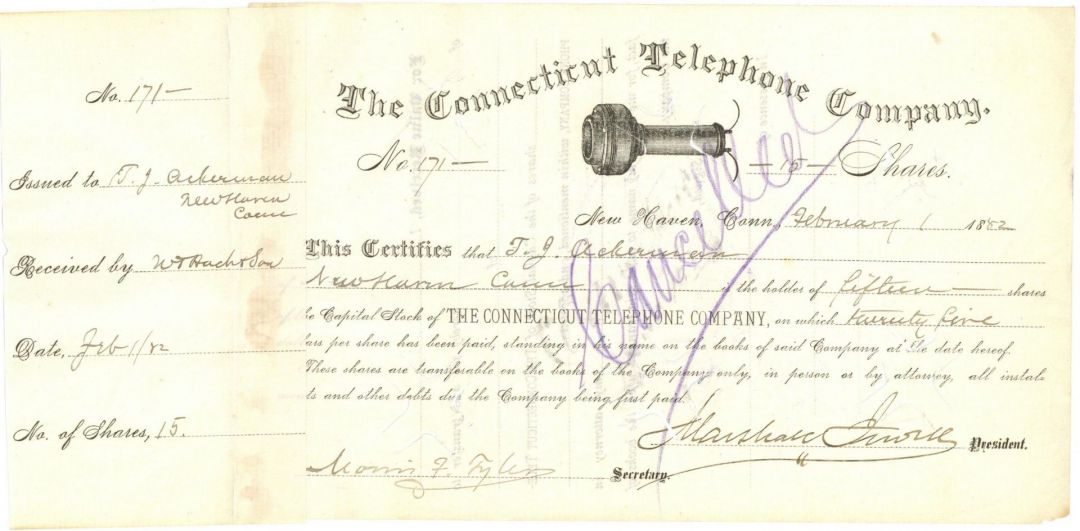Connecticut Telephone Co. - Signed by Marshall Jewell Autograph Stock Certificate dated 1882
Inv# TT1027 StockStock signed by Marshall Jewell (October 20, 1825 – February 10, 1883) who was a manufacturer, pioneer telegrapher, telephone entrepreneur, world traveler, and political figure who served as 44th and 46th Governor of Connecticut, the US Minister to Russia, the 25th United States Postmaster General, and Republican Party National Chairman. Jewell, distinguished for his fine "china" skin, grey eyes, and white eyebrows, was popularly known as the "Porcelain Man". As Postmaster General, Jewell made reforms and was intent on cleaning up the Postal Service from internal corruption and profiteering. Postmaster Jewell helped Secretary of the Treasury Benjamin H. Bristow shut down and prosecute the Whiskey Ring. President Grant, however, became suspicious of Jewell's loyalty after Jewell fired a Boston postmaster over non payment of a surety bond and asked for his resignation.
A native of New Hampshire, Jewell was the son of a prominent tanner and currier. Having apprenticed in his father's tannery business, Jewell moved to Boston where he learned the art of being a currier. In 1847, Jewell moved to Hartford where he worked for his father's business as a currier. Jewell stopped working as a currier and became a skilled telegrapher, where he worked in New York, Ohio, and Tennessee. Jewell was a Whig who supported the election of Zachary Taylor to the office of the Presidency. Having supported Taylor, Jewell moved to Mississippi where he was elected General Superintendent of Telegraphers. Jewell moved back to New York in 1849, and in 1850 he returned to his father's tannery business having entered into partnership with his father. Between 1859 and 1860, Jewell traveled to and visited Europe on business connected with the tannery firm, having returned to the United States during the onset of the American Civil War. In 1865 Jewell returned to Europe and traveled to Egypt and the Holy Land. Read more at https://en.wikipedia.org/wiki/Marshall_Jewell
Payphones were preceded by pay stations, staffed by telephone company attendants who would collect rapid payment for calls placed. The Connecticut Telephone Co. reportedly had a payphone in their New Haven office beginning 1 June 1880; the fee was handed to an attendant. In 1889, a public telephone with a coin-pay mechanism was installed at the Hartford Bank in Hartford, Connecticut, by the Southern New England Telephone Co. It was a "post-pay" machine; coins were inserted at the end of a conversation. The coin mechanism was invented by William Gray; he was issued a series of patents for his devices, beginning with U.S. Patent 454,470 issued 23 June 1891 for a "Signal Device for Telephone Pay-Stations" which rang a bell for each coin inserted. He subsequently founded the Telephone Pay Station Co. in 1891. The "pre-pay" phone debuted in Chicago in 1898. By 1902, there were 81,000 payphones in the United States. By 1905, the first outdoor payphones with booths were installed. By the end of 1925, 25,000 of these booths existed in New York City alone. In 1960, the Bell System installed its one millionth telephone booth. Booths, which were expensive, gradually faded away not much later. Read more at https://en.wikipedia.org/wiki/Payphone
A stock certificate is issued by businesses, usually companies. A stock is part of the permanent finance of a business. Normally, they are never repaid, and the investor can recover his/her money only by selling to another investor. Most stocks, or also called shares, earn dividends, at the business's discretion, depending on how well it has traded. A stockholder or shareholder is a part-owner of the business that issued the stock certificates.










Ebay ID: labarre_galleries